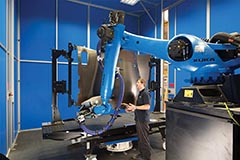Safran Engineering Services banks on its software suite
11/10/2023
LEAP engine fan blades, fixed internal structure panels for their nacelles and internal landing gear pistons all have one thing in common: their quality is inspected and assessed using non-destructive testing (NDT), for which Safran Engineering Services has developed the SMV2 software suite and it considers the development prospects to be promising.
Safran Nacelles’ Burnley site is synonymous with the manufacture of nacelle systems and thrust reversers. In recent years, the site had been primarily associated with the Airbus A330, but is now embarking on new programmes such as the Airbus A320neo and the Comac C919.
The Group therefore called on internal and external expertise to develop high-performance NDT tools. One of the most ambitious, enabling the inspection of fixed internal nacelle structure panels, is based on an infrared thermography inspection method using a flash and a thermal camera. “This is an innovative method. Others use digital tomography, 2D digital radiography or visual inspection with high-definition digital cameras,” explained Marc Garas, Application Software Service Manager at Safran Engineering Services.
Safran Engineering Services has been involved in the research phases of these projects from the outset and has developed a software suite, a veritable toolbox that can be adapted to different testing projects.
 | ||
| The SMV2 software suite is integrated into a robotised cell to perform multiple functions |
This software suite, known as SMV2, has been designed for the Group’s various use cases, from the different acquisition methods (thermography, tomography, radiography and digital cameras) to the geometric specificities of each part and the types of peculiarities to be investigated. The human-machine interfaces (HMIs) have been the subject of extensive ergonomic research to help inspectors in their work.
Integrated into a robotised cell, the software suite performs multiple functions. “In the case of nacelle parts, it communicates with the robotised cell and controls the infrared camera built into the cell, as well as the flash that heats the surface of the part. It allows images to be analysed by an operator to detect any defects. It supervises the entire process in real time and stores information in a database that can then be used by data scientists or production managers,” said Marc. An inspection report, which is used to validate the part, can then be generated automatically.
He continued: “We must also aim to constantly improve the software’s algorithms, in close collaboration with Safran Tech, to obtain the best detection and characterisation performance, reduce the system’s learning time and continue to work on simplified ergonomics that facilitate analysis.”
To aid the deployment of NDT projects within Safran, an initial consortium agreement was signed at the Paris Air Show between Safran Engineering Services, Axiome and Groupe ADF (Latesys), manufacturers of the robotised cell and integrators. “This agreement demonstrates Safran’s confidence in the product, which is part of the digitalisation of the Group’s processes, known as Manufacturing 4.0.
Whether in maintenance, repair or operations (MRO), the potential applications to be addressed are enormous. This will enable us, by 2024, to provide a global, high-performance, tailor-made non-destructive testing solution, with a robotised cell and secure integrated software suite, within the Group and even beyond; in short, a major step towards digital continuity,” concluded Marc.